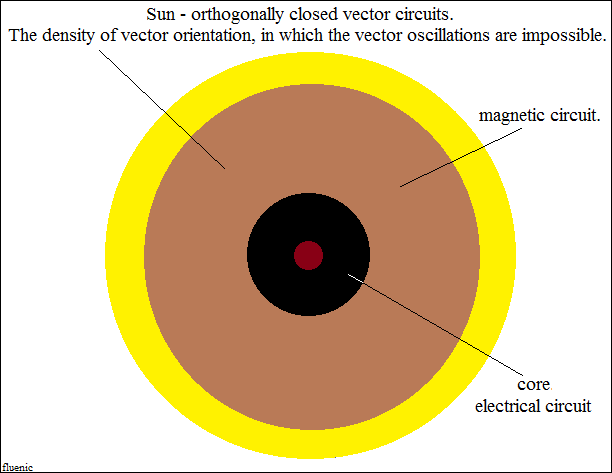The density of vector
space.
In the materialist conception, the definitions of energy, pressure, and
density
are ambiguous. However, the energy of explosive gases, enclosed in cylinders
of variable volume, was used, creating weapons and internal combustion
engines. Vector quantities were only an object of mathematical analysis.
Energy is the vector quantity of the interaction of vector properties.
When the forces of attraction between the polarities of the vectors formed
a
closed vector circuit, the property of orthogonality simultaneously formed
the orthogonal circuit. The attractive forces in each circuit became centripetal
vector forces. The two symmetrical circuits, compressing each other,
microscopically formed a stable, solid, cold vector structure, matter,
hydrogen.
Microscopic circuits enter into resonance with external frequencies, oscillate
and dilate. Obviously, the energy of vector space is the generating form
of
nature's existence, far from being fundamental. The symmetrical structure
of
hydrogen is imposed by its microscopic size. The macroscopic form of the
orthogonally closed vector circuits through the polarities of the hydrogen
structures is asymmetric, of the macroscopic size. In these structures,
one of
the circuits called electric is completely surrounded by the other circuit
called
magnetic, so they cannot have oscillations. The macroscopic structures
of
the surrounding space are known as galactic systems, stellar systems,
vortices,
cyclones, etc. The sun is a star, the centripetal forces of orthogonally
closed
vector circuits produce, in the sphere of hydrogen gas, reactions still
unknown.
The reactions are determined by the exponential increase of the density
towards
the center, of the mutual pressure between the orthogonal vector circuits.
In the chromosphere, the density of hydrogen gas favors the multiplication
of hydrogen structures and vector bonds, fusions and fissions.
In the photosphere, the pressure, the density of the hydrogen gas, continuously
shortens the wavelengths of the emitted oscillations and decomposes the
structure of the hydrogen. In other words, the photosphere continuously
decomposes the hydrogen structures coming from the chromosphere, into
the radiation of the emitted frequency spectrum. The photosphere layer
can
be thicker at the equator and thinner towards the poles. The photosphere
maintains the kinetic state of energy, the temperature, at its maximum
level.
The radiation spectrum emitted by the photosphere is omnidirectional.
Towards the center, however, for hundreds of thousands of km of radius,
through the huge orientation density of orthogonally closed vector circuits,
oscillations become impossible. The vector
circuit called electric, the core
that compresses the magnetic axis is a black hole, not at millions of
K, but at
zero K. No one can imagine the huge potential energy state of oriented
vector circuits around the electrical core of a galaxy, called a black
hole.
Here, vector oscillations are impossible!

